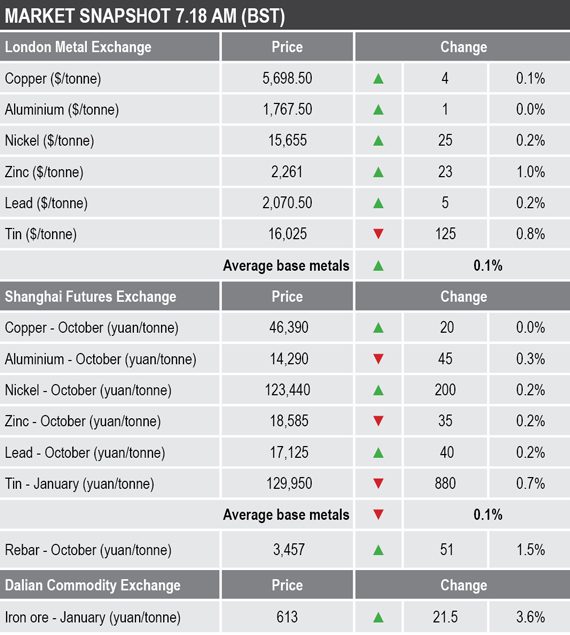Thursday’s flash manufacturing purchasing managers’ indices (PMI) showed US manufacturing moving into contraction for the first time since 2009, while Japan and Europe remained in contraction mode.
- Asian and European equity markets are mostly firmer this morning
- Market waiting to see if central bankers have fresh ideas to boost growth…
- …all eyes are on US Federal Reserve chair Jerome Powell when he speaks at Jackson Hole
Base metals
There are two main movers amongst the three-month base metals on the London Metal Exchange this morning, that being zinc that is up by 1% and tin that is down by 0.8%. The rest lie between being little changed to up by 0.2%. Copper is up by 0.1% at $5,698.50 per tonne.
In China, base metals prices on the Shanghai Futures Exchange were mixed, with the October contracts for copper, nickel and lead slightly firmer, while October aluminium and zinc were weaker and January tin was down by 0.7%. October copper was recently at 46,390 yuan ($6,550) per tonne, up by just 20 yuan per tonne from Thursday’s close.
Spot copper prices in Changjiang were down by 0.2% at 46,220-46,350 yuan per tonne and the LME/Shanghai copper arbitrage ratio was higher at 8.13, compared with 8.09 on Wednesday.
Precious metals
Spot gold and silver prices were little changed this morning, with gold recently quoted at $1,496.86 per oz compared with $1,497.35 per lb at Thursday’s close, while silver was up by 0.1% at $17.05 per oz. Spot platinum prices were up by 0.5% while those for palladium were off by 0.1%.
On the SHFE, the December gold and silver contracts were both down by 0.2%.
Wider markets
The spot Brent crude oil price was recently quoted at $60 per barrel – its recent range being $55.86-61.48 per barrel.
The yield on benchmark US 10-year treasuries has rebounded; it was recently quoted at 1.6566% having been at 1.5849% at a similar time on Wednesday. The German 10-year bund yield is firmer too at -0.6100%, compared with -0.6680% at a similar time on Wednesday.
In equities, Asian indices were mainly firmer on Friday: Nikkei (+0.4%), Hang Seng (+0.55%), Kospi (-0.14%), the ASX200 (+0.33%) and the CSI 300 (+0.83%).
This follows a mixed performance in Western markets on Thursday: in the United States, the Dow Jones Industrial Average closed up by 0.19% at 26,252.24 and in Europe the Euro Stoxx50 closed down by 0.63% at 3,373.67.
Currencies
The dollar index is consolidating in high ground and was recently quoted at 98.36 – the recent range being 97.21-98.94. The yen (106.65) has eased from recent strength at 105.05, the euro (1.1068) is drifting lower again, as are the Australian dollar (0.6753) and sterling (1.2204) – that is after sterling’s rebound on Thursday to 1.2272.
The yuan has weakened further and was recently at 7.0871.
Key data
On the economic agenda for Friday, there is data on China’s leading indicators and US new home sales, but the main focus will be Powell’s speech, to see if the central banks have come up with fresh ways to tackle the low-inflation environment.
Today’s key themes and views
In the base metals, weak demand dominates where there are not imminent supply concerns. With US manufacturing slipping into contraction, it may be that US President Donald Trump starts to worry about next year’s elections and prompts him to get on with a new trade deal. For now the risk remains to the downside, but better news on a trade deal could emerge at any time and that could turn sentiment round quickly, but for now it is a waiting game.
Gold prices are consolidating but given the stress from geopolitical issues, world trade and global economic growth, gold is likely to remain sought-after. Key to how robust the bull market in gold will be how well the dip is supported.



